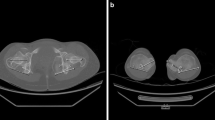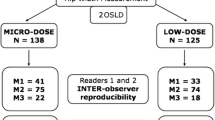Abstract
Limb-lengthening procedures include a series of radiographic examinations to follow the lengthening process and callus formation. We quantified ionizing radiation exposure during lengthening treatment and estimated the risks associated with this exposure in 53 patients undergoing lengthening procedures. Field size and tube voltage of all radiographs and fluoroscopy time during surgery were recorded. According to conversion factor tables of organ doses, the cumulative organ dose was estimated. Location of lengthening, age, complications during lengthening procedure, range of lengthening, healing index, and other factors affecting the duration of the lengthening procedures were analyzed. Average lengthening was 4.8 cm (range, 3.0–12.5 cm). The average cumulative organ dose for a straight lengthening procedure was 3.1 mSv (range, 0.2–12.5 mSv). The average organ dose per centimeter of lengthening was 0.7 mSv/cm (range, 0.03–5.9 mSv/cm). Doses for patients with tibial lengthening (0.3 mSv/cm) were less than doses for patients with femoral lengthening (1.1 mSv/cm). Age, complications, range of lengthening, and healing index did not influence the dosage of radiation per centimeter lengthening. We judge the average patient’s exposure during a limb-lengthening procedure as tolerable, but femur lengthening results in a higher cumulative organ dose.
Level of Evidence: Level II, prognostic study. See the Guidelines for Authors for a complete description of levels of evidence.
Similar content being viewed by others
References
Aronson J, Good B, Stewart C, Harrison B, Harp J. Preliminary studies of mineralization during distraction osteogenesis. Clin Orthop Relat Res. 1990;250:43–49.
Drexler G, Panzer W, Petoussi N, Zankl M. Effective dose: how effective for patients? Radiat Environ Biophys. 1993;32:209–219.
Fischgrund J, Paley D, Suter C. Variables affecting time to bone healing during limb lengthening. Clin Orthop Relat Res. 1994;301:31–37.
Gruber G, Konermann W. Possibilities and limitations of ultrasonography in corticotomy/callus distraction. Orthopade. 2002;1:172–175.
Hughes TH, Maffulli N, Green V, Fixsen JA. Imaging in bone lengthening: a review. Clin Orthop Relat Res. 1994;308:50–53.
Ilizarov GA. The tension-stress effect on the genesis and growth of tissues. Part I. The influence of stability of fixation and soft-tissue reservation. Clin Orthop Relat Res. 1989;238:249–281.
Ilizarov GA. The tension-stress effect on the genesis and growth of tissues. Part II. The influence of the rate and frequency of distraction. Clin Orthop Relat Res. 1989;239:263–285.
International Commission on Radiological Protection. 1990 Recommendations of the ICRP (ICRP Publication 60). Ann ICRP. 1990;21.
International Commission on Radiological Protection. Avoidance of radiation injuries from medical interventional procedures (ICRP Publication 85). Ann ICRP. 2000;30.
Matsuyama J, Ohnishi I, Sakai R, Bessho M, Matsumoto T, Miyasaka K, Harada A, Ohashi S, Nakamura K. A new method for evaluation of fracture healing by echo tracking. Ultrasound Med Biol. 2008;34:775–783.
Paley D. Current techniques of limb lengthening. J Pediatr Orthop. 1988;8:73–92.
Perisinakis K, Damilakis J, Theocharopoulos N, Papadokostakis G, Hadjipavlou A, Gourtsoyiannis N. Patient effective dose and radiogenic risks from fluoroscopically assisted surgical reconstruction of femoral fractures. Radiat Prot Dosimetry. 2004;108:65–72.
Petoussi-Henss N, Zankl M, Drexler G, Panzer W, Regulla D. Calculation of backscatter factors for diagnostic radiology using Monte Carlo methods. Phys Med Biol. 1998;43:2237–2250.
Poretti GG. Radiation exposure of a population due to diagnostic x-ray examinations: some critical remarks. Phys Med Biol. 1985;30:1017–1027.
Regulla D, Griebel J, Nosske D, Bauer B, Brix G. Acquisition and assessment of patient exposure in diagnostic radiology and nuclear medicine. Z Med Phys. 2003;13:127–135.
Zhou XZ, Zhang G, Dong QR, Chan CW, Liu CF, Qin L. Low-dose X-irradiation promotes mineralization of fracture callus in a rat model. Arch Orthop Trauma Surg. 2008 Apr 22 [Epub ahead of print].
Acknowledgments
We thank Norbert Meier from the Institute of Clinical Radiology of the University Hospital of Münster and Brigitte Schulze for their cooperation during the measurements and data collection.
Author information
Authors and Affiliations
Corresponding author
Additional information
Each author certifies that he or she has no commercial associations (eg, consultancies, stock ownership, equity interest, patent/licensing arrangements, etc) that might pose a conflict of interest in connection with the submitted article.
Each author certifies that his or her institution has approved or waived approval for the human protocol for this investigation and that all investigations were conducted in conformity with ethical principles of research.
About this article
Cite this article
Schiedel, F.M., Buller, T.C. & Rödl, R. Estimation of Patient Dose and Associated Radiogenic Risks from Limb Lengthening. Clin Orthop Relat Res 467, 1023–1027 (2009). https://doi.org/10.1007/s11999-008-0624-6
Received:
Accepted:
Published:
Issue Date:
DOI: https://doi.org/10.1007/s11999-008-0624-6




